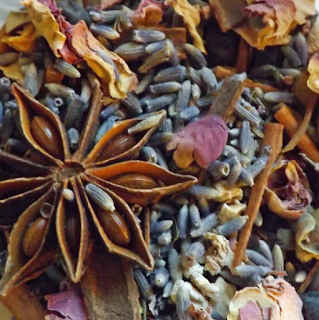I haven't enjoyed moving to Mountain View, but when I'm walking here and there, I can at least enjoy the abundance of flowers here. For a few moments, the fragrance takes me away from where I am. Long stretches of jasmine, large and fragrant roses, and the blossoming trees stop me in my tracks, and all is right and beautiful. I move on sadly, looking forward to the next moment when the scent of flowers fills the air.
I spent several years trying to figure out what to do with my life. I knew I wanted to start my own business at some point, but it took awhile to figure it out. When I started studying perfumery, I knew that I wanted to work with these captivating materials. I feel intoxicated after spending a day in a room full of essential oils, absolutes, and other aromatics. Sometimes it will make me giddy, excited, and just happier. Other times it's so intense and I need to step out for fresh air.
When I started Ivre de Fleurs, I knew I wanted to focus on natural fragrance. Knowing that not everyone likes or wears perfumes, I decided to include bath and body products, like lip balms, hair oils, etc. These would let me share the fragrances with a wider group of people, and allow me to work with different mediums as well.
As time went by and I developed the brand, my mind was pulled this way and that. The products I made and the direction of my brand have led me to a point where I look at what I have, and I'm not excited by it. I've barely blogged the past few months, and without
Instagram, I would have barely done anything with social media. I'm not a real fan of social media - I'm more of a keep to myself kind of person - but I keep hearing how important it is for business.
I've spent the time experimenting and studying the past few months, and also figuring out where I want my brand to head. Along the way I pondered so many possibilities, each tempting, but they would take away from what I really want to do. And that is create beautiful and strange fragrances. I'm going to refocus my creative energies on scent creation. I'm going to make lip balms, hair oils, and a few other products, but for now at least, I won't be making soap.
Ivre de Fleurs translates to "drunk with flowers," but so far I've aimed for a more restrained, quiet brand. I hope to breathe life into it with the passion I feel for the materials, and the wild beauty I strive to capture.
"In the room the women come and go
Talking of Michelangelo.
The yellow fog that rubs its back upon the window-panes,
The yellow smoke that rubs its muzzle on the window-panes,
Licked its tongue into the corners of the evening,
Lingered upon the pools that stand in drains,
Let fall upon its back the soot that falls from chimneys,
Slipped by the terrace, made a sudden leap,
And seeing that it was a soft October night,
Curled once about the house, and fell asleep.
And indeed there will be time
For the yellow smoke that slides along the street,
Rubbing its back upon the window-panes;
There will be time, there will be time
To prepare a face to meet the faces that you meet;
There will be time to murder and create,
And time for all the works and days of hands
That lift and drop a question on your plate;
Time for you and time for me,
And time yet for a hundred indecisions,
And for a hundred visions and revisions,
Before the taking of a toast and tea.
In the room the women come and go
Talking of Michelangelo."
-T.S. Eliot, The Love Song of J. Alfred Prufrock














